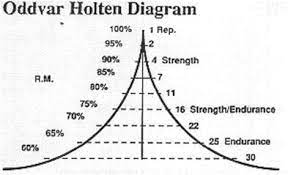Are you confused on how many repetitions you should be doing when you are working out? How much weight is too much weight? Should I be doing higher repetitions or more weight?
Many people work out regularly and wonder why they aren’t getting the results they want. How do you figure it out? Well, the big question that needs answering is: what are you trying to accomplish? Depending on your answer, you will change the way you train.
The different ways to progress or begin an exercise program are based upon two things: weight + repetitions.
The below image is the Holten curve which describes how to gauge your weight and repetitions:

Strength training is based upon 1 repetition max. This is the amount of weight that you can lift once before you experience max fatigue. It is hard to do this without causing potential injury if you have not lifted heavy before.
The best way to determine this is how many repetitions you can complete before your maximum fatigue (i.e. when you physically cannot do it anymore).
For example, if you can complete 20 repetitions, you are more focused on endurance and if you can complete only 8, then you are focusing on building strength.
We will dive into this more below:
Higher repetitions and lower weight: targets endurance, improves blood flow (vascularity) and lean muscle mass
This is ideal If you are starting a new exercise routine. First, you want to make sure you can perform the exercise properly without any weight.
It is important to master the form because adding load (weight) to the exercise can increase the potential for injury.
In this case, you would do higher repetitions (like 20 repetitions) with lower weight. As you can see on the curve, you are targeting more endurance while focusing on your form. This will help you ease into a workout routine to start or after an injury. This is also helpful if you are aiming to develop more lean muscle mass. If you are building strength with higher repetitions, it is important that you may have to train to failure (ie. inability to perform more without rest).
Once you have mastered your form, and wanted to be able to lift heavy, moving on to higher weight may be ideal for you. For example, if you can perform a proper squat without limitations, you could start add weight.
Higher weight and lower repetitions: builds strength and larger muscle mass
It’s important to note that even when you add weight to your exercises, the switch from high repetitions to low repetitions isn’t a sprint! When you are ready, add weight on little by little. With that weight added, it can still be good to first start with higher repetitions until you can reassess and can lock down proper form with your new weight.
Once you have done that, you can continue to load heavier and you will slowly shift from lower weight to higher weight.
Keep in mind, everyone is different. If you are having any concerns about your exercise form or experiencing limitations in your exercise program, reach out to us. We have extensive experience in helping people return to their normal fitness routines safely.
Written by Mary Grimberg, PT, DPT, OCS




